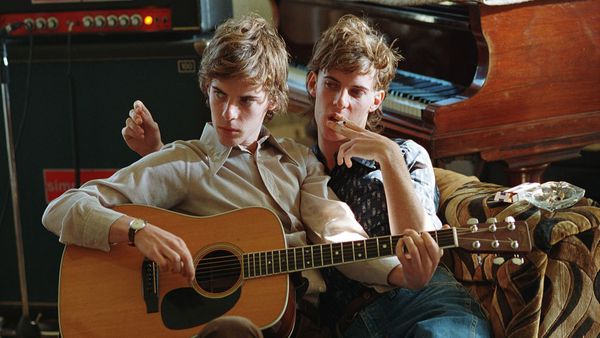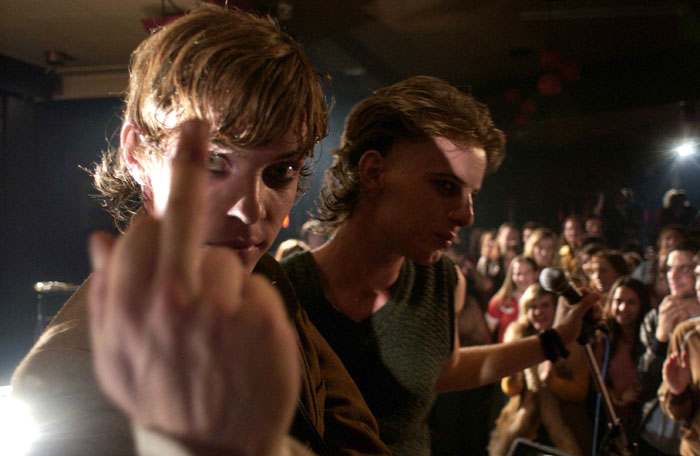‘Brothers of the Head:’ The Forgotten Parasitic Twin Horror

Note: Spoilers ahead for James Wan’s Malignant
Malignant is all the horror community is talking about right now, inspiring polarizing conversations from lauding and loving to whole-hearted hatred. It’s bold and original, even as it borrows some familiar motifs from films that have come before it. Comparisons to Basket Case are widespread. But for me it triggered the memory of a much lesser-known gothic tale of parasitic twins, one that blinked out of public consciousness as quickly as it arrived; first in science fiction writer Brian Aldiss’ 1977 book Brothers of the Head and then again in the 2005 mockumentary of the same name.
The story follows conjoined twins Tom and Barry Howe (played by real-life twins Harry and Luke Treadaway in their first-ever onscreen roles) throughout their rise to pop-punk stardom and decades after their subsequent mortal fall. Add into the mix the near-demonic presence of a third latent twin (which resides on Barry’s shoulder as a half-formed third head in the book and manifests as a fetal tumor in Barry’s brain in the film), it becomes clear why Brothers of the Head feels like Malignant’s forgotten predecessor.
Related: ‘Malignant’ Review: James Wan’s Goriest, Most Audacious Romp is the Best Horror Movie of 2021 So Far
But while Malignant had much to say about the giallo, about camp and horror and what big budgets can do for the genre, Brothers of the Head is a much more philosophical work. Both the book and film are platforms for exploring identity, isolation, privacy, consciousness, and the exploitation and autonomy of disabled people. much like its protagonists. They are best consumed as a pair; the book, a deep red wine of rhapsodic vintage, and the film a steak bleeding the life-blood of its ill-fated characters.
In a barren Norfolk wasteland, the Howe Twins’ legacy remains a distant memory to all but those who knew them best. Enter Roberta “Robbie” Howe, their older sister:
“This volume is a memorial to the unhappy life of my brothers— their strange, unrealized, dual life. Although it ended in murder, and many people […] have said that my brothers’ entire existence was a form of slow murder, they did enjoy happier times.”
Brothers of the Head
Thus begins what The Observer called “a refined punk fable” and The Sunday Times reported as “an eloquent symbol of all we fear from our subconscious minds.”
The Howe Twins’ mother died during childbirth, leaving them with their indifferent father and caring sister on an imaginary islet called L’Estrange Head. There they are raised in isolation, running wild in windswept grasses but plagued by poverty. Their lack of socialization and education leaves them ill-prepared when a lawyer who specializes in “the legal and managerial problems connected with the exploitation of cheap music and young people” arrives to collect them on behalf of rich benefactor and record producer Zak Bedderwick.

Upon the promise of a salary for themselves and their father, and with no other prospects, they are whisked away to a secluded mansion called Humbleden. There, they are trained to sing and play guitar. When Barry proves the more difficult of the twins, he endures abuse via beatings, cold water hoses, and stun-guns, mostly perpetrated by manager Nick Sydney.
Now stage-ready, the brothers’ debut under the band name Bang-Bang. What follows is a meteoric rise in which “deformity (becomes) chic.” Their irreverent performances prompt British lawmakers to enter the debate about whether or not disabled people should “be allowed to flaunt their sexuality.” Onstage, they seethe with restless power, teasing their audience with glimpses of the skin that binds them. Devoted fans flock to their shows out of “morbid curiosity” and the press dwell on the question: “What [is] their sex-life like?”
In both the book and the film, the boys’ social and sexual awakenings, as well as the drink and drugs supplied by their keepers, are the catalysts for the rousing of the third latent twin, though the book explores this character’s desire for bodily autonomy and revenge much more thoroughly. As Barry’s behavior becomes more erratic in Bedderwick’s punk-rock Bedlam, it is clear that his thoughts and actions may not be entirely his own. Tom is plagued by the third brothers’ dreams as he sleeps, ill at ease as he cries out: “Unbury me. Unbury me. Un-Barry me.”
Their story culminates in a haunting finale: the violent showdown between body, mind, and subconscious that ends in death for all.
“That thing was awake, Tom. It is alive, it has thoughts. I don’t think it is any friend of mine or yours. Suppose it wakes fully and you’re reduced to unconsciousness…”
Brothers of the Head
The tale of the Howe twins closely mirrors that of real-life conjoined twins Daisy and Violet Hilton, on which Brothers of the Head is loosely based. Like the Howes, the Hiltons were sold by their parents. Their earliest years were spent as an exhibit in a room above an English pub, controlled by physical and psychological abuse. They were taught to sing and dance and toured Europe as a sideshow act. They never received any of the wages they earned. As adults, they became best known for their role in Tod Browning’s Freaks, yet they never escaped the abuse of the managers who took them on. They spent the last eight years of their tragic lives as reclusive grocery store clerks in North Carolina. In 1969, they were found dead in their home. Daisy had died first, Violet tethered to her deceased twin for at least two days before passing away herself.

The film pays homage to Daisy and Violet when the twins receive sheet music for a Hilton Sisters duet and are ordered to recreate it in Bang-Bang’s style. And like the Hiltons, all that is left of Tom and Barry’s legacy in the decades after they fade from public memory is archival footage and the one record they produced.
Indeed, the film is accompanied by a fast-paced soundtrack performed both live and in-studio by the Treadaway twins (with one song co-written by Buzzcocks founder Pete Shelley) and acts as the dessert in our Brothers of the Head meal. Within the lyrics lay the Howe Twins’ secrets, pathways into their minds and souls that make them more than a caged exhibit. It makes them devastatingly human, and their voices powerful.
“Two to one and one is three // Are you you? Or are you me?”
Brothers of the Head
The story of their lives is threaded with cerebral intervals, supposed memories and dreams of the malformed third brother, and footage from an incomplete Ken Russell-biopic of the twins entitled Two-Way Romeo. Voyeuristic, gritty found-footage shows the twins bathing and sleeping, implicating the viewer as an accomplice. It is a unique tragedy that (perhaps inadvertently) becomes a deeply empathetic story about disabled bodies, the individuals that reside in them, and global attitudes toward disabled folks — like those faced by the Hilton Sisters — that endure today.
You will not find explicit horror here. You will not see blood beyond the scrapes and bruises left on Barry’s chin by his manager, or those remnants of the twins following their shocking end. There will be no jump-scares. This is a story that works its way under your skin, a tale that focuses on blame, culpability, and the corruption of innocence, in which the real horror lay not in the twins’ vengeful fetal twin, but in the abuse and lack of accountability that awakened it.
Categorized:News

